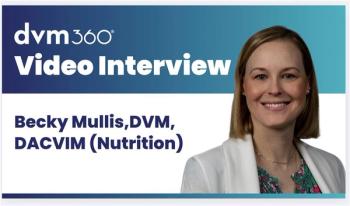
An Interview with... Dr. Niels C. Pedersen
Dr. Pedersen set out to add to our knowledge of feline virology. He succeeded. Among other notable accomplishments, he co-discovered the feline immunodeficiency virus in 1986. Today, he is the director of the Center for Companion Animal Health and the Veterinary Genetics Laboratory at the UC Davis School of Veterinary Medicine.
What's the most exciting change you've seen in veterinary medicine?
I would never have predicted that veterinary and human medicine would be unified to their present degree. By applying human medicine to our own patients, we have made tremendous strides in the quality of care that we offer our patients. I am excited about how the veterinary specialties have developed and how our clients have evolved in their medical sophistication and veterinary expectations.
Feline medicine was a vacuum waiting to be filled, and I have done my best to fill it.
Who was your most memorable patient and why?
When I was an intern at Colorado State University in 1967-1968, we received a litter of Chihuahuas with severe ringworm. I worked hard to clear up the ringworm so that I could find them homes. However, I overestimated the demand for these little dogs, and we were reaching the point of having to put them down. At the same time, I had an older client who had a hunting dog with an incurable brain tumor. This dog was this man's whole world, and I knew that he would take its death hard. So after I euthanized his old dog, I sat him and his wife down and presented him with one of these puppies, carefully explaining that it would soon be put down for lack of a home. He became angry, threw the puppy back into my arms, and stormed out. No dog could replace his old dog! His wife came back a minute later, said she knew he would change his mind, and asked if she could take the puppy. Six weeks later, she phoned. The puppy had grown fond of her husband, but he was not reciprocating. A few weeks later, she said that her husband would let the dog sit on his lap occasionally. After a few more weeks, she informed me that her husband and the Chihuahua were inseparable. From this experience, I learned that people go through a grieving period, and only when their grief is spent, will they open their hearts to a new pet.
Who inspired you most in your career and why?
I've had many inspiring people in my life. Some inspired me in a positive manner, and some in a negative manner (i.e. they served as a positive example by being a bad example). Strangely, I am equally grateful to both. For example, I went to college to become a high school vocational agriculture teacher, but my experience with my instructors in this area was so bad that I switched to animal sciences. In animal sciences, I took an overview course in animal diseases from the head of the veterinary sciences department that opened my eyes to veterinary medicine. While at the University of California-Davis, my veterinary career continued to be influenced by what I believe to be the greatest veterinary faculty ever assembled.
But the greatest influence in my life was my parents. I inherited the mantle of being a son of immigrants. Interestingly, as I look at the successes of my own children, I think that my relatively uneducated parents had far more influence on me than my children's well-educated parents have had on them.
What was the best professional advice you ever received?
Two pieces of advice that I will always cherish came in my last year of veterinary school. I really loved and had an aptitude for many things. So what should I do after graduation? I asked Dr. Peter Kennedy, my pathology instructor, for advice. Dr. Kennedy said, "Niels, do you believe that there is only one woman for you and that if you don't find her, you will forever be unhappy?" That was his advice? Suddenly, it dawned on me. Dr. Kennedy was telling me that I was fortunate to have so many options and that whatever I ended up doing, I would be successful.
The second piece of advice came from Dr. Bill Pritchard, the school's dean. I asked him the same question I'd asked Dr. Kennedy, and he told me he had the answer. He had visited the John Curtin School of Medical Research at the Australian National University on several occasions and was most impressed with Dr. Bede Morris, a comparative pathologist and immunologist. He told me to go to Australia after my internship and earn a PhD under Dr. Morris. I did, and it was a life-changing experience.
What would you advise a new graduate?
My advice is to always start with the best. If it is an internship, find the hospital where you will learn the most. If it is a residency, choose the institution that has the best specialists in your desired field. And if you're seeking graduate training, only consider the best research groups. If you start out well, the next steps in your career will be easy and rewarding.
Are you a cat person or a dog person?
I love all types of animals, but I am definitely a cat person. I grew up on a poultry farm in southern California and was always surrounded by cats. I love to see the way cats move in their environments, and their behavioral quirks never cease to amaze me. I like their independent nature, the unique ways that they respond to stress, and even their diseases. I started veterinary school interested in cows (my second animal love) but saw a huge need for knowledge on feline disorders. In 1967, feline medicine was a vacuum waiting to be filled, and I have done my best to fill it.
What do you consider the greatest threat to the profession?
The greatest threat is our increasing preoccupation with making money. The veterinary profession has long been known for its caring attributes, but many of our clients are now seeing a new, and not so caring, aspect of the profession.
A second threat concerns our loss of identity. If our veterinary schools concentrate on human-type medical care in their teaching hospitals, and on NIH-type research, they will become, in essence, more medical schools. Veterinary schools must continue to embrace human medicine but also concentrate on areas that are uniquely their own, for example, food safety, shelter medicine, animal-based forensics, nutrition, zoonotic and vector-borne diseases, production medicine and the effects of food production on the environment, aquaculture, the role of animals in society, and more.
Which animal health needs are currently unmet?
Individual pets are receiving very good veterinary care; however, a big deficiency exists in the care animals in shelters receive. The veterinary profession, until recently, has pretty much stayed away from shelters. Yes, some veterinarians do work with shelters, but the unique disease, management, and design problems of shelters have not been appreciated.
What is your sci-fi prediction for veterinary medicine?
We will discover the genetic code for every phenotypic trait of every animal species: what makes a claw, a finger, a hoof, an arm, a wing, etc. We will then use this knowledge to engineer new animals and to recreate species that have long been extinct. This is really not sci-fi to me—it will happen!
Newsletter
From exam room tips to practice management insights, get trusted veterinary news delivered straight to your inbox—subscribe to dvm360.






